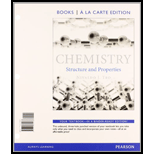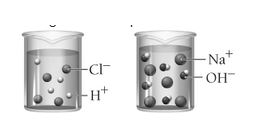
Chemistry: Structures and Properties, Books a la Carte Plus MasteringChemistry with eText -- Access Card Package
1st Edition
ISBN: 9780321974617
Author: Nivaldo J. Tro
Publisher: PEARSON
expand_more
expand_more
format_list_bulleted
Question
Chapter 9, Problem 76E
Interpretation Introduction
Interpretation:
“The excess ions are due to incomplete neutralization of HCl and NaOH” should be identified.
Concept introduction:
One mole of HCl will be neutralized by one mole of NaOH. So, for each molecule of HCl we need one molecule of NaOH to just neutralize it.
Given:
Two beakers represent the solution of HCl and NaOH.

Expert Solution & Answer
Want to see the full answer?
Check out a sample textbook solution
Students have asked these similar questions
Please help with this graph.
ogin - PaymentN
MapQuest
3
Overview - SAP NetW...
Draw the major product of this reaction. Ignore inorganic byproducts.
CI
1. NaBH4
2. H₂O
C Clever | Portal Job Op
Problem
Atoms, Bonds
and Rings
Draw or tap a new bond to
2. Draw the remaining two resonance structures for the carbocation intermediate in the
meta nitration of methyl benzoate AND explain why the meta orientation is preferred.
Hint: how is the placement of the cation favorable after addition of nitronium relative to
the electron withdrawing group? (2 pts)
H NO2
CO₂Me
Chapter 9 Solutions
Chemistry: Structures and Properties, Books a la Carte Plus MasteringChemistry with eText -- Access Card Package
Ch. 9 - Prob. 1SAQCh. 9 - What mass (in grams) of Mg(NO3)2 is present in 145...Ch. 9 - Prob. 3SAQCh. 9 - Potassium iodide reacts with lead(ll) nitrate in...Ch. 9 - Which solution forms a precipitate when mixed with...Ch. 9 - What is the net ionic equation for the reaction...Ch. 9 - What is the net ionic equation for the reaction...Ch. 9 - What is the net ionic equation for the reaction...Ch. 9 - What is the oxidation state of carbon in CO32-? +3...Ch. 9 - Prob. 10SAQ
Ch. 9 - Prob. 11SAQCh. 9 - What is an aqueous solution? What is the...Ch. 9 - What is molarity? How is it useful?Ch. 9 - Explain how a strong electrolyte, a weak...Ch. 9 - What is an acid? Explain the difference between a...Ch. 9 - What does it mean for a compound to be soluble?...Ch. 9 - What are the solubility rules? How are they...Ch. 9 - Which cations and anions form compounds that are...Ch. 9 - What is a precipitation reaction? Give an example.Ch. 9 - How can you predict whether a precipitation...Ch. 9 - Explain how a molecular equation, a complete ionic...Ch. 9 - Prob. 11ECh. 9 - Prob. 12ECh. 9 - Prob. 13ECh. 9 - Explain the principles behind an acid-base...Ch. 9 - Prob. 15ECh. 9 - Which reactant types give rise to gas-evolution...Ch. 9 - Prob. 17ECh. 9 - What are oxidation states? How can oxidation...Ch. 9 - What happens to a substance when it becomes...Ch. 9 - In a redox reaction, which reactant is the...Ch. 9 - Prob. 21ECh. 9 - Prob. 22ECh. 9 - What is the molarity of NO3- in each solution?...Ch. 9 - What is the molarity of Cl- in each solution?...Ch. 9 - Prob. 25ECh. 9 - Prob. 26ECh. 9 - A laboratory procedure calls for making 400.0 mL...Ch. 9 - Prob. 28ECh. 9 - If 123 mL of a 1.1 M glucose solution is diluted...Ch. 9 - If 3.5 L of a 4.8 M SrCl2 solution is diluted to...Ch. 9 - To what volume should you dilute 50.0 mL of a 12 M...Ch. 9 - Prob. 32ECh. 9 - Consider the precipitation reaction:...Ch. 9 - Consider the reaction:...Ch. 9 - What is the minimum amount of 6.0 M H2SO4...Ch. 9 - What molarity of ZnCl2forms when 25.0 g of zinc...Ch. 9 - You mix a 25.0 mL sample of a 1.20 M potassium...Ch. 9 - Prob. 38ECh. 9 - For each compound (all water soluble), would you...Ch. 9 - Classify each compound as a strong electrolyte or...Ch. 9 - Determine whether each compound is soluble or...Ch. 9 - Prob. 42ECh. 9 - Prob. 43ECh. 9 - Complete and balance each equation. If no reaction...Ch. 9 - Write a molecular equation for the precipitation...Ch. 9 - Write a molecular equation for the precipitation...Ch. 9 - Write balanced complete ionic and net ionic...Ch. 9 - Write balanced complete ionic and net ionic...Ch. 9 - Mercury ions (Hg22+) can be removed from solution...Ch. 9 - Lead ions can be removed from solution by...Ch. 9 - Name each acid. Hl(aq) HNO3(aq) H2CO3(aq)Ch. 9 - Name each acid HCI(aq) HClO2(aq) H2SO4(aq)Ch. 9 - Provide the formula for each acid hydrofluoric...Ch. 9 - Provide the formula for each acid phosphoric acid...Ch. 9 - Write balanced molecular and net ionic equations...Ch. 9 - Write balanced molecular and net ionic equations...Ch. 9 - Complete and balance each acid-base equation...Ch. 9 - Complete and balance each acid-base equation...Ch. 9 - A 25.00-mL sample of an unknown HClO4solution...Ch. 9 - A 30.00-mL sample of an unknown H3PO4 solution is...Ch. 9 - Complete and balance each gas-evolution equation:...Ch. 9 - Prob. 62ECh. 9 - Write a balanced equation for the reaction between...Ch. 9 - Prob. 64ECh. 9 - Assign oxidation states to each atom in each...Ch. 9 - Prob. 66ECh. 9 - Prob. 67ECh. 9 - Prob. 68ECh. 9 - Determine whether or not each reaction is a redox...Ch. 9 - Determine whether or not each reaction is a redox...Ch. 9 - Prob. 71ECh. 9 - Prob. 72ECh. 9 - People often use sodium bicarbonate as an antacid...Ch. 9 - Toilet bowl cleaners often contain hydrochloric...Ch. 9 - Prob. 75ECh. 9 - Prob. 76ECh. 9 - Predict the products and write a balanced...Ch. 9 - Predict the products and write a balanced...Ch. 9 - Prob. 79ECh. 9 - Prob. 80ECh. 9 - Prob. 81ECh. 9 - A solution contains Cr3+ ion and Mg2+ ion. The...Ch. 9 - Find the volume of 0.110 M hydrochloric acid...Ch. 9 - Find the volume of 0.150 M sulfuric acid necessary...Ch. 9 - Treatment of gold metal with BrF3 and KF produces...Ch. 9 - We prepare a solution by mixing 0.10 L of 0.12 M...Ch. 9 - A solution contains Ag +and Hg2+ions. The addition...Ch. 9 - The water in lakes that have been acidified by...Ch. 9 - Recall from Section 8.5 that sodium carbonate is...Ch. 9 - A solution contains one or more of the following...Ch. 9 - A solution contains one or more of the following...Ch. 9 - Prob. 92ECh. 9 - Prob. 93ECh. 9 - Prob. 94ECh. 9 - Prob. 95E
Knowledge Booster
Learn more about
Need a deep-dive on the concept behind this application? Look no further. Learn more about this topic, chemistry and related others by exploring similar questions and additional content below.Similar questions
- Label all absorptions over 1500 cm-1. Please be specific and mark IR if needed for explanation. Compound OH sp^3 C-H C=O C-O Triglyceridearrow_forwardIdentify the intermediate that is INITIALLY formed in a saponification reaction (hydrolysis of an ester). III -OH H₂O HO OH HO O || A B C III D IV IVarrow_forwardHelp me answer this practice sheet I found for an answer guidearrow_forward
- show the retrosynthesis of this molecule step by step starting with 1,3-dimethoxy benzene H3CO OH OH OCH 3arrow_forwardConsider the reaction of a propanoate ester with hydroxide ion shown below. A series of four alcohol leaving groups were tested to determine which would be the best leaving group. Based on the pKa values of the alcohols, predict which alcohol would produce the fastest hydrolysis reaction. HO FOR A Alcohol I, pKa =16.0 B Alcohol II, pKa =10.0 C Alcohol III, pKa = 7.2 + ROH D Alcohol IV, pKa = 6.6arrow_forwardCurved arrows are used to illustrate the flow of electrons. Using the provided starting and product structures, draw the curved electron-pushing arrows for the following reaction or mechanistic step(s). Be sure to account for all bond-breaking and bond-making steps. :0: NaOH, H₂O 00:4 Na O heat NaO Select to Add Arrows Select to Add Arrows :0: Na a NaOH, H2O :0: NaOH, H2O heat heat Na ONH Select to Add Arrowsarrow_forward
- Curved arrows are used to illustrate the flow of electrons. Using the provided starting and product structures, draw the curved electron-pushing arrows for the following reaction or mechanistic step(s). Be sure to account for all bond-breaking and bond-making steps. H CH3NH3+ :0: :0: HO CH3NH2 HH iSelect to Add Arrows i Select to Add Arrows i HH CH3NH3+ CH3NH2 Select to Add Arrows i CH3NH3 CH3NH2 ايكدا HH Select to Add Arrowsarrow_forwardThe reaction is carried out with gases: A → B + C at 300 K. The total pressure is measured as a function of time (table). If the reaction order is 2, calculate the rate or kinetic constant k (in mol-1 L s¹) Ptotal (atm) 492 676 760 808 861 t(s) 0 600 1200 1800 3000arrow_forwardcan someone give a description of this NMR including whether its a triplt singlet doublet where the peak is around at ppm and what functional group it representsarrow_forward
- 1. Determine the relationship between the following molecules as identical, diastereomers, or enantiomers (6 points, 2 points each). OH OH OH A-A OH HOT HO- ACHN and HO- ACHN OH HO HO ° OH and OH OH SH and ...SHarrow_forward20,0 Complete the electron pushing mechanism to y drawing the necomery unicaciones and carved on for Step 1: Add curved arms for the tint step, traiment with NalilĻ. The Nation 458 Step 2: Added for the second step, inalment with), how the "counterion bar Step 3: Daw the products of the last simplom organic and one incoganic spacient, including all nonbondingarrow_forwardplease provide the structure for this problem, thank you!arrow_forward
arrow_back_ios
SEE MORE QUESTIONS
arrow_forward_ios
Recommended textbooks for you
 Chemistry: Principles and PracticeChemistryISBN:9780534420123Author:Daniel L. Reger, Scott R. Goode, David W. Ball, Edward MercerPublisher:Cengage Learning
Chemistry: Principles and PracticeChemistryISBN:9780534420123Author:Daniel L. Reger, Scott R. Goode, David W. Ball, Edward MercerPublisher:Cengage Learning Introductory Chemistry: A FoundationChemistryISBN:9781337399425Author:Steven S. Zumdahl, Donald J. DeCostePublisher:Cengage Learning
Introductory Chemistry: A FoundationChemistryISBN:9781337399425Author:Steven S. Zumdahl, Donald J. DeCostePublisher:Cengage Learning Chemistry & Chemical ReactivityChemistryISBN:9781133949640Author:John C. Kotz, Paul M. Treichel, John Townsend, David TreichelPublisher:Cengage Learning
Chemistry & Chemical ReactivityChemistryISBN:9781133949640Author:John C. Kotz, Paul M. Treichel, John Townsend, David TreichelPublisher:Cengage Learning Living By Chemistry: First Edition TextbookChemistryISBN:9781559539418Author:Angelica StacyPublisher:MAC HIGHER
Living By Chemistry: First Edition TextbookChemistryISBN:9781559539418Author:Angelica StacyPublisher:MAC HIGHER Chemistry: Principles and ReactionsChemistryISBN:9781305079373Author:William L. Masterton, Cecile N. HurleyPublisher:Cengage Learning
Chemistry: Principles and ReactionsChemistryISBN:9781305079373Author:William L. Masterton, Cecile N. HurleyPublisher:Cengage Learning General Chemistry - Standalone book (MindTap Cour...ChemistryISBN:9781305580343Author:Steven D. Gammon, Ebbing, Darrell Ebbing, Steven D., Darrell; Gammon, Darrell Ebbing; Steven D. Gammon, Darrell D.; Gammon, Ebbing; Steven D. Gammon; DarrellPublisher:Cengage Learning
General Chemistry - Standalone book (MindTap Cour...ChemistryISBN:9781305580343Author:Steven D. Gammon, Ebbing, Darrell Ebbing, Steven D., Darrell; Gammon, Darrell Ebbing; Steven D. Gammon, Darrell D.; Gammon, Ebbing; Steven D. Gammon; DarrellPublisher:Cengage Learning

Chemistry: Principles and Practice
Chemistry
ISBN:9780534420123
Author:Daniel L. Reger, Scott R. Goode, David W. Ball, Edward Mercer
Publisher:Cengage Learning

Introductory Chemistry: A Foundation
Chemistry
ISBN:9781337399425
Author:Steven S. Zumdahl, Donald J. DeCoste
Publisher:Cengage Learning

Chemistry & Chemical Reactivity
Chemistry
ISBN:9781133949640
Author:John C. Kotz, Paul M. Treichel, John Townsend, David Treichel
Publisher:Cengage Learning

Living By Chemistry: First Edition Textbook
Chemistry
ISBN:9781559539418
Author:Angelica Stacy
Publisher:MAC HIGHER

Chemistry: Principles and Reactions
Chemistry
ISBN:9781305079373
Author:William L. Masterton, Cecile N. Hurley
Publisher:Cengage Learning

General Chemistry - Standalone book (MindTap Cour...
Chemistry
ISBN:9781305580343
Author:Steven D. Gammon, Ebbing, Darrell Ebbing, Steven D., Darrell; Gammon, Darrell Ebbing; Steven D. Gammon, Darrell D.; Gammon, Ebbing; Steven D. Gammon; Darrell
Publisher:Cengage Learning
Acid-Base Equilibrium; Author: Bozeman Science;https://www.youtube.com/watch?v=l5fk7HPmo5g;License: Standard YouTube License, CC-BY
Introduction to Titrimetric analysis; Author: Vidya-mitra;https://www.youtube.com/watch?v=uykGVfn9q24;License: Standard Youtube License